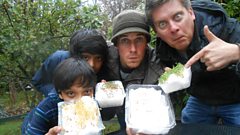
15/01/2013
Mel Giedroyc takes a trip to the British Museum and hears about a hill-walking rubbish collector. Dick and Dom join her for more everyday science in How Dangerous Is Your Garden.
Last on
Clip
-
![]()
Dick and Dom: Plants
Duration: 12:37
Chapters
-
How Dangerous Is Your Garden – Part 2
Dick and Dom explore the soggy science behind plants.
Duration: 13:41
Rob The Rubbish – Saturday Live
Retired Welshman Rob Kevan describes why he spends his spare time cleaning the hills of Snowdonia.
Duration: 06:47
Dame Jacqueline Wilson - My Life In Five Books – Part 2
The author of this week’s story Dustbin Baby discusses the book she bought but has never read by the French writer Marcel Proust.
Duration: 07:33
Birthday – James Nesbitt
The Hobbit actor chats to Kirsty Young about his idyllic upbringing in Northern Ireland.
Duration: 05:50
Magical Mystery Tour – The British Museum
Curator David Thompson introduces some of the many watches and clocks housed in the British Museum.
Duration: 07:50
Dustbin Baby – Episode 2
The second part of Dame Jacqueline Wilson’s story about April, the young girl abandoned in a dumpster as a child.
Duration: 13:34
Activity 1. Colour-changing flowers
White flowers can change colour overnight – here’s how.
��
This activity requires adult supervision if using a knife.
��
You will need:
- White flowers, such as carnations or daisies
- Various containers filled with water
- Food colourings – any colour should work
- Scissors or a knife
First, add some drops of food colouring to each container of water – don’t be too cautious, give it a good glug so that the water has a deep colour. Now cut the ends of the stems of the flowers. Do this underwater if possible, so that the cut is fresh and no air bubbles get in. Then put the flowers into the containers and leave them there overnight.
��
In the morning, you should see that that the flowers are tinted with the colour of the water.
If you slice across the stem, you should see the coloured water leaking out from the fine channels that carry it up the plant. What’s happening?��
The stems of the flowers are acting like straws sucking up water from the glass. This process begins at the top in the leaves and the petals, where water in the plant evaporates into the air. This creates a vacuum that pulls water up from the bottom of the stem. Overnight, the coloured water should reach the petals at the top and become visible …
��
If you want to take this activity to the next level, try splitting the stem of a flower and balancing it in two differently coloured containers of water, you’ll get a half-and-half coloured flower.
Activity 2. Cress, cress everywhere
Investigate what conditions are best for plants, by growing cress seeds in various different conditions.
��
You will need:
- Several packets of cress seeds
- 4 plastic food trays filled with cotton wool to grow the seeds on
- Water
First, give three of the trays a good soaking with water. Now sprinkle cress seeds on them.
��
Position one tray in a warm room, in the light.
Position one tray in a cold room, in the light.
Position one tray in a warm cupboard, in the dark.
��
Sprinkle the remaining seeds on fourth tray with the dry cotton wool as a comparison.
Wait for a week, then bring all the trays together so that you can compare them. (Keep a note of which one’s which!) What’s happening?��
You should see that there are differences in how well the seeds have grown. Seeds need air, light, water and warmth to grow, so the best conditions for them are in a warm room, with daylight. In our experiment Dick and Dom found the cress grown in the dark was bushy but yellow in colour, and the cress grown in the cold was stunted in size compared to the seeds grown in warmth. The seeds that received no water will not have grown at all, which is why you can buy seeds in packets and they won’t do anything until you plant and water them.
Activity 3. Make your own dew
You will need:
- A smooth-sided empty tin can with the label taken off
- Water
- Icecubes
- A stirrer
Half fill the tin can with cold water from the tap. Now add ice cubes one by one. Stir each one round to let it cool the water down before adding the next one. Keep your eyes on the outside of the tin can. In a while you’ll see a fine mist appearing on the outside of the can, which will go on to turn into droplets of water. What’s happening?
��
The tin can isn’t leaking, what you’re seeing is condensation of water vapour from the air onto the can.
��
The air around us is full of water vapour, and the warmer the air, the more water vapour it can contain. When it cools, water vapour changes state into liquid water.��In this experiment, when you cool the can down with the ice cubes, the water vapour in the air around the can turns into droplets of water. You’ll probably have seen a similar effect in the car, when your car windows steam up. This happens when the temperature of the air outside the car is colder than inside, cooling the glass down. The glass then acts in the same way as the tin can, causing the water to change state.
��
This is equivalent to the dew you see lying on the grass in the morning sometimes. The cold ground, caused the water vapour to condense out of the air into droplets of water.
Broadcast
- Tue 15 Jan 2013 16:0091�ȱ� Radio 4 Extra

